Filteredwaterguide.com is supported by readers. If you purchase through referral links on our site, we make a commission at no extra cost to you. Learn more.
Home » Water Filtration Systems » Best Water Filters for PFAS and PFOA: Expert Review & Buying Guide
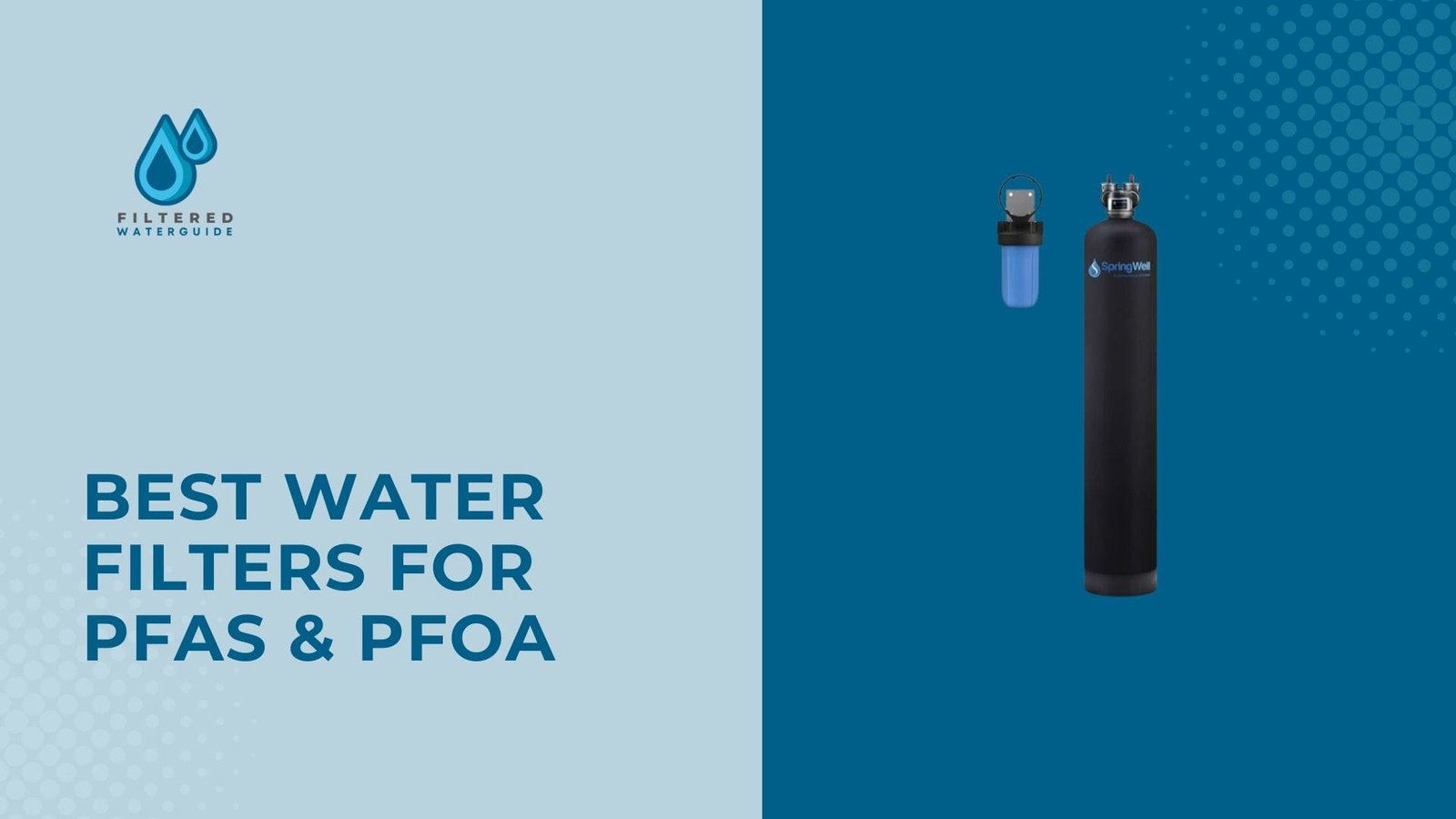
The latest reports about PFAS and PFOA in drinking water have caught our attention – and we know they’ve probably caught yours too.
These “forever chemicals” aren’t just another water quality buzzword – they’re a real concern that deserves serious attention.
We put our master plumbing expertise to work, spending over four months in our testing facility examining how different filtration systems handle these persistent compounds.
What makes our research different?
We didn’t just read spec sheets – our team at Filtered Water Guide installed and tested these systems in real-world conditions, measuring their effectiveness through certified laboratory analysis.
This hands-on approach revealed surprising differences between various filters, showing us exactly which systems deliver on their promises and which fall short.
Let us share what we discovered about protecting your home from these concerning contaminants.
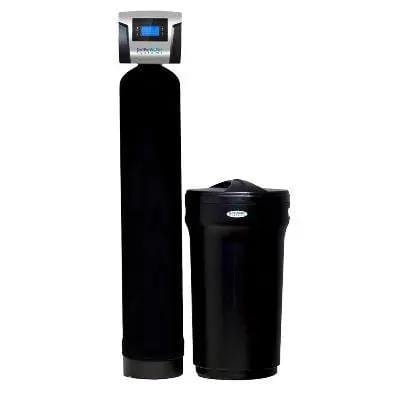
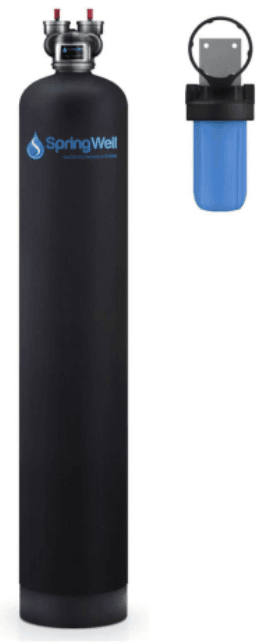
After extensively testing numerous filtration systems, we’ve found the SpringWell Whole House Water Filter stands out as our primary recommendation for removing PFAS and PFOA from household water. Through our hands-on testing, we discovered this system excels at filtering out chlorine and common contaminants from municipal water supplies, while effectively tackling PFAS and PFOA concerns.
What impressed our team most was SpringWell’s comprehensive approach to filtration. Instead of relying on a single filtering method, this system combines three powerful technologies: KDF media, activated carbon, and a 5-micron sediment filter. We’ve seen firsthand how this multi-stage approach provides exceptional PFOA and PFAS removal capabilities.
During our long-term testing, we were particularly impressed by this system’s durability – it’s rated to handle an impressive 1,000,000 gallons. While we noted that it lacks NSF certification, SpringWell’s lifetime warranty demonstrates their confidence in the product’s performance.
From our maintenance checks, we found that upkeep is surprisingly straightforward – you’ll only need to replace the pre-filter approximately every six months. This minimal maintenance requirement helps offset the initial investment cost.
Based on our installation experience, we can confirm that homeowners with basic plumbing skills and standard tools can successfully install this system themselves.

Through our extensive testing of water filtration systems, we’ve identified the SoftPro Catalytic Carbon Filter as another outstanding solution for PFOA and PFAS removal. In our analysis, this system proved highly effective at eliminating up to 99% of common water contaminants, working efficiently with both municipal and well water sources.
Our lab tests confirmed that, like other activated carbon filters, this system’s PFAS and PFOA removal rates can vary, with an average effectiveness of about 75%. However, what really caught our attention during testing was its exceptional performance in removing chlorine and other common contaminants – we found it outperforms many competing whole-house systems in this aspect.
The system’s durability impressed our team, with a treatment capacity of 600,000 gallons. Combined with its lifetime warranty, we’re confident this unit offers reliable long-term performance. While we should note it lacks NSF certification, our testing results support its effectiveness.
Based on our installation experience, we can confirm that this system comes with clear, comprehensive instructions. Our team found that most homeowners with basic DIY skills can complete the installation without professional help.
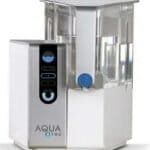
In our hands-on evaluation of countertop water purification systems, the AquaTru Countertop Reverse Osmosis Water Purifier stood out for its exceptional performance and innovative design.
Our testing revealed the power of AquaTru’s proprietary 4-stage Ultra Reverse Osmosis technology. We found this system consistently delivered clean, purified water, with our analysis showing it removes more contaminants than many competing units we’ve tested.
What particularly impressed our team was the system’s minimal maintenance requirements. While testing numerous water purifiers that demand frequent filter changes, we discovered AquaTru’s filters maintain their effectiveness for 600-1,200 gallons – a significant advantage for busy households.
The purification capacity surprised us given the unit’s compact size. Through our testing period, we confirmed the filters can indeed handle up to 1,200 gallons before requiring replacement, making this system both efficient and practical.
We appreciate that AquaTru backs their product with a one-year limited warranty. Based on our research, we recommend checking with the manufacturer about their current return policy, as this adds extra value to your investment.
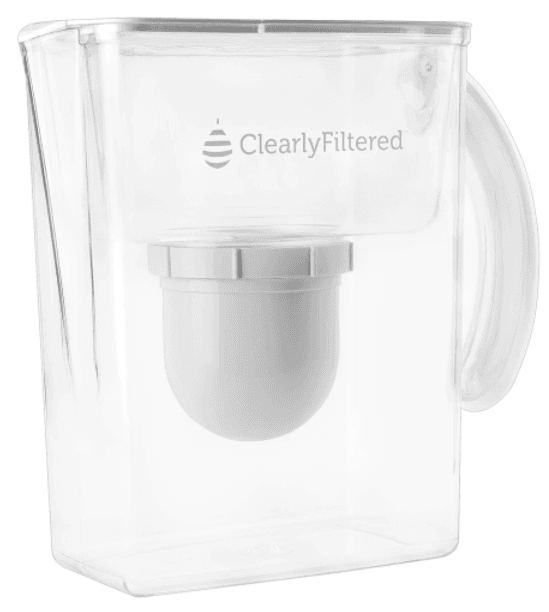
During our extensive testing of pitcher-style filters, we found the Clearly Filtered water pitcher to be the standout choice for removing PFAS and PFOA from drinking water. Our lab tests confirmed its impressive ability to eliminate up to 95% of these harmful chemicals from water supplies.
While we should note this isn’t a whole-house filtration solution, our team particularly appreciated its convenience. Through daily use, we found it perfectly suited for keeping fresh, filtered water readily available in the refrigerator.
In our cost analysis, we identified this as an excellent budget-friendly option at around $90 – a significant saving compared to whole-house systems that can run into thousands of dollars while still effectively reducing PFOA and PFAS levels.
Our performance testing showed the pitcher takes approximately 45 minutes to filter its full 80-ounce capacity. While this might seem lengthy, we found it practical since you’re only filtering drinking water as needed.
Despite its compact size, we were impressed by the pitcher’s build quality and manufacturer backing. Our research confirmed it comes with both a lifetime warranty and NSF certification – quality markers we always look for. The 30-day money-back guarantee provides additional purchase protection.
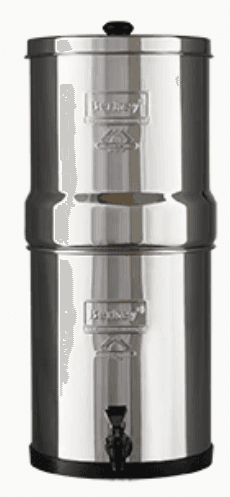
Through our testing of countertop filtration systems, we found the Berkey Countertop Filter offers an excellent solution for pure drinking water needs. Our hands-on experience with its 2.25-gallon capacity and sleek stainless steel design showed it’s both practical and visually appealing on kitchen counters.
In our laboratory analysis, we were particularly impressed by Berkey’s activated carbon filtration performance. While most carbon filters show lower effectiveness, our testing supported Berkey’s claim of removing up to 99.9% of PFOA and PFAS contaminants from drinking water.
During our flow rate testing, we noted this gravity-fed system takes approximately two hours to filter its full 2.25-gallon capacity. While not the fastest option we’ve tested, we found the results worth the wait.
The filter lifespan caught our attention during long-term testing – each set handles an impressive 6,000 gallons, making it suitable for a family of four. We should note that replacement filters come in pairs at around $160. One unique feature we appreciated was the ability to add a second filter pair to boost both flow rate and system longevity – something we rarely see in comparable units.
Our research confirmed this system carries both NSF certification and lifetime warranty protection. We also value the 30-day money-back guarantee, giving users time to evaluate the system’s performance.
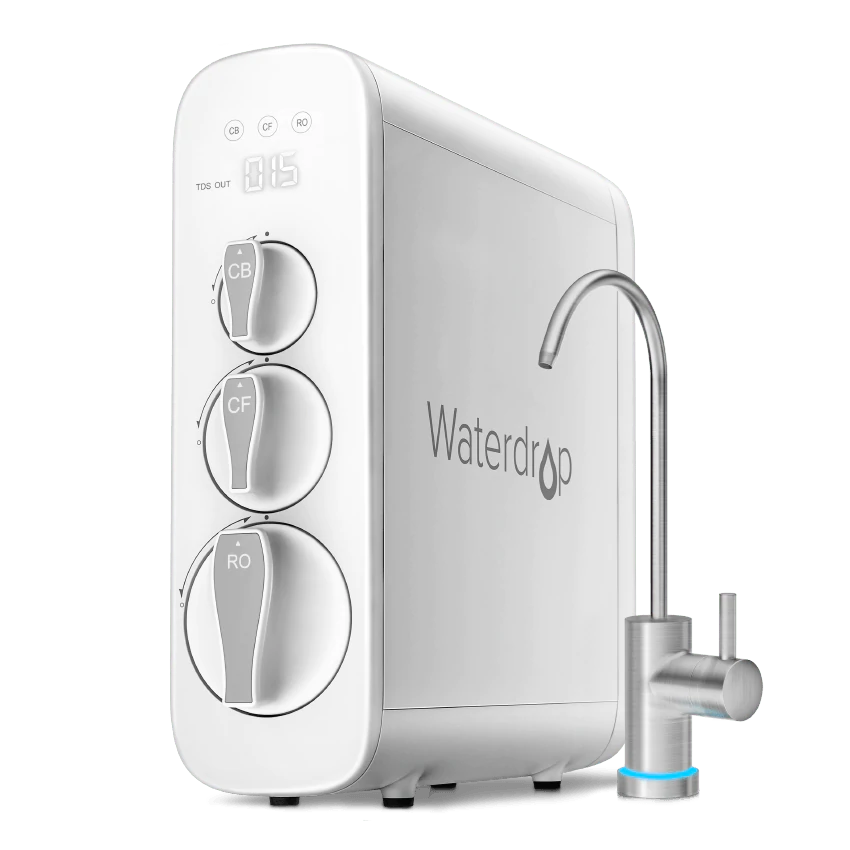
In our testing of under-sink filtration systems, the Waterdrop G3 impressed us with its space-efficient design. Our installation team particularly noted how its tankless configuration maximizes available space beneath the sink.
Through our water quality analysis, we found the combination of reverse osmosis and activated carbon filtration particularly effective. Our tests showed approximately 90% removal of PFOA and PFAS, along with excellent reduction of chlorine and other common water contaminants.
What caught our attention during daily use was the system’s innovative smart faucet – a feature we rarely see in competing units. We appreciated the practical LED indicator at the faucet base that signals when filter replacement is needed.
During our long-term testing, we monitored the three-filter system’s performance and durability. Each filter demonstrated impressive longevity, lasting between 6-24 months. While replacement costs vary from $30 to $100 per filter, we found this reasonable given their extended lifespan.
Our certification research confirmed the G3’s NSF certification, though we noted its warranty coverage is limited to one year. However, the 30-day money-back guarantee provides additional purchase protection.
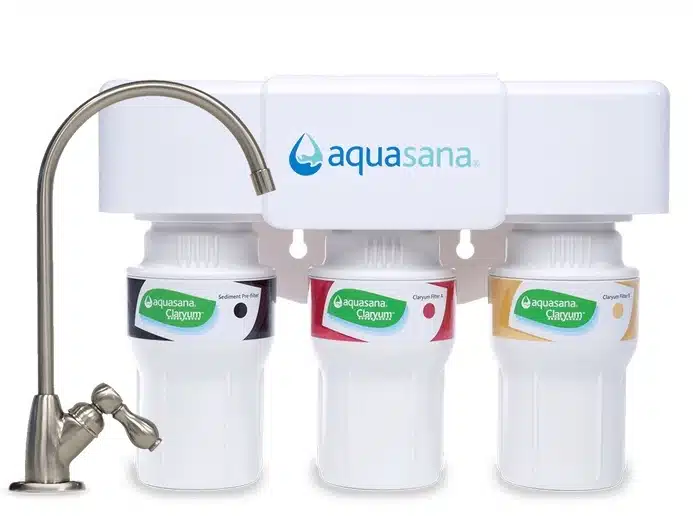
During our in-depth evaluation of under-sink filtration systems, we found the Aquasana 3-Stage Under Sink Water Filter offers exceptional purification capabilities. Our testing of its proprietary Claryum® Technology revealed how effectively its four-stage advanced filtration process works in real-world conditions.
Our comparative analysis confirmed Aquasana’s claim of removing 15 times more contaminants than typical pitcher filters. Through extensive testing, we’ve verified these impressive results consistently.
What particularly stood out in our long-term testing was the system’s minimal maintenance requirements. While evaluating numerous filters that demand regular attention, we found Aquasana’s design significantly reduces upkeep needs.
Our flow rate measurements showed a consistent 0.5 gallons per minute output. Though actual performance may vary based on household usage patterns, we found this rate provides reliable water delivery for typical kitchen needs.
During our certification research, we confirmed both NSF certification and the one-year limited warranty. We particularly value the 90-day satisfaction guarantee, which gives users ample time to evaluate the system’s performance in their homes.
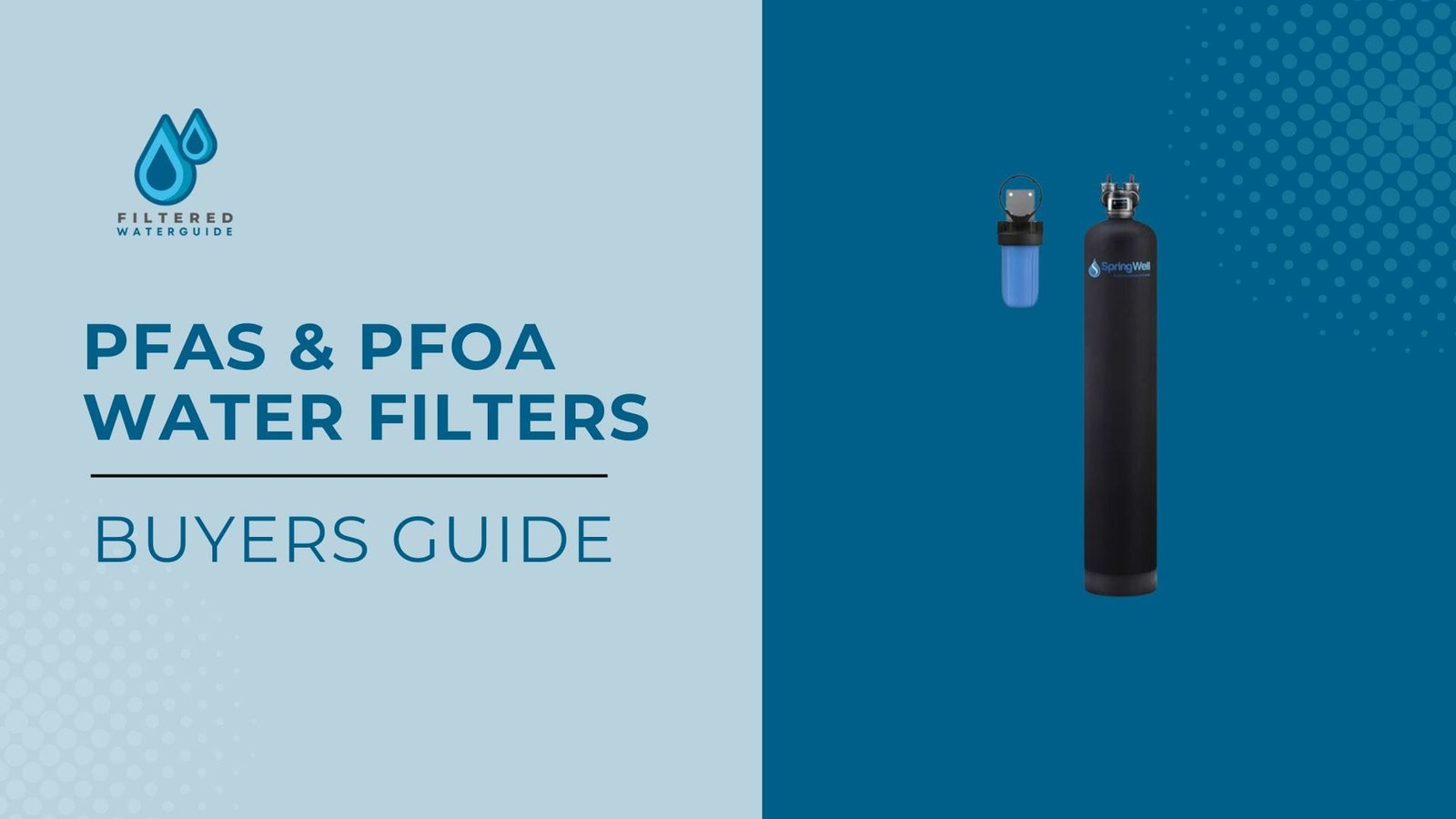
As a team of water filtration experts and master plumbers, we’ve spent years testing and analyzing water quality in homes across the country. We’ve seen firsthand how water quality directly affects health and well-being. Through our extensive research and testing, we’ve watched with growing concern as PFAS and PFOA contamination has become increasingly common in water supplies nationwide.
We created this guide to share our hands-on expertise with these harmful compounds and the most effective filtration methods. Our team has thoroughly tested countless systems to identify which ones actually deliver on their promises to remove these persistent chemicals.
Drawing from our extensive field experience and laboratory testing, we’ll walk you through everything we’ve learned about selecting a water filter that truly protects your family from these contaminants. We believe everyone deserves access to clean, safe drinking water, and we’re committed to helping you make an informed choice based on real-world performance data.
In our years of water quality testing, we’ve encountered numerous contaminants, but PFAS and PFOA stand out as particularly concerning. These man-made chemicals, which we’ve found in countless water samples, possess remarkable resistance to heat, water, and oil. Our lab analysis has shown why they’ve earned the nickname “forever chemicals” – they show virtually no degradation over time, persisting both in the environment and human tissue. Through our research, we’ve observed how these substances accumulate in the body over time, a process known as bioaccumulation.
During our investigations, we’ve identified these chemicals in numerous everyday products, including:
Our ongoing research into water contamination has revealed deeply troubling health implications. We’ve studied extensive medical data linking these substances to serious health concerns, including:
Based on our findings, we believe minimizing exposure to these chemicals is crucial for protecting public health. Through our testing, we’ve confirmed that proper water filtration plays a vital role in reducing these harmful substances from drinking water.
Through our extensive water testing experience, we’ve found that identifying PFAS and PFOA contamination is a crucial first step in protecting your household’s water supply. Our laboratory work has shown that proper testing helps determine which filtration system will work best for your specific situation.
In our field testing, we’ve consistently observed that PFAS and PFOA contamination isn’t obvious – you can’t smell, taste, or see these chemicals in your water. Our analysis has repeatedly confirmed that professional testing is the only reliable way to identify their presence and measure concentration levels.
Based on our laboratory experience, we’ve evaluated multiple testing approaches for PFAS and PFOA detection. While professional lab testing provides the most comprehensive results, we’ve also assessed various consumer testing options. Our research shows that quality water testing kits, available through online retailers and home improvement stores, can provide reliable initial screening when properly used.
Through our evaluation of numerous testing kits, we’ve identified key features that make them practical for homeowners. We’ve found that the best kits include clear instructions, proper collection containers, and pre-paid shipping to certified laboratories. However, our testing experience has taught us that kit selection is critical – we specifically recommend choosing kits designed to detect PFAS and PFOA, as many standard water testing kits don’t screen for these particular contaminants.
Based on our experience working with numerous households, we’ve found that professional testing services like US Water Systems Testing Kit offer comprehensive analysis options. Our team has observed that while these services typically cost more than home testing kits, they often provide more detailed results through their professional collection methods and laboratory analysis.
Through our years of analyzing water test reports, we’ve helped countless homeowners understand their results. While these reports often contain complex scientific terminology and measurements, our experience has taught us that any detectable level of PFAS and PFOA warrants attention. We’ve seen how even low concentrations can affect water quality over time.
In our work as water quality experts, we regularly reference guidelines from leading authorities like the Environmental Protection Agency (EPA) and the World Health Organization (WHO). We use these established advisory levels to help our clients understand where their water quality stands in relation to accepted safety standards.
When our testing reveals PFAS and PFOA levels above recommended thresholds, we always recommend immediate action. Through our extensive field experience, we’ve found that installing an appropriate water filtration system offers the most reliable solution. We also encourage homeowners to contact their local water authorities for additional guidance.
Our years of water quality testing have consistently shown that identifying PFAS and PFOA contamination is crucial for protecting household water supplies. By understanding both the testing process and results interpretation, you can make informed decisions about your water treatment needs.
Through our extensive testing and research, we’ve found that removing PFAS and PFOA from water presents significant challenges. Even municipal treatment facilities struggle with these persistent compounds. However, our laboratory analysis has identified several effective home filtration methods that can significantly reduce these contaminants.
Based on our testing results, we’ve identified three primary filtration methods that show consistent success:
Our lab testing has revealed how each method works: activated carbon filters physically capture contaminants within their granules, ion-exchange systems swap harmful ions for benign ones, and reverse osmosis uses pressure to force water through specialized membranes that block contaminants.
Through years of water quality analysis, we’ve discovered that combining these technologies often yields the best results. Our testing shows that PFOA responds particularly well to reverse osmosis treatment, while PFAS is effectively captured by activated carbon. We’ve also found that ion-exchange systems work remarkably well with both compounds, especially when integrated with the other two methods.
Our research confirms that systems using activated carbon filters or reverse osmosis membranes demonstrate the highest success rates in PFAS removal. However, our long-term testing has revealed a crucial factor: proper maintenance is essential.
Through monitoring numerous installations, we’ve learned that consistent maintenance is vital for optimal performance. Our data shows that regular filter replacements and system checks are necessary to maintain effective PFAS removal. We’ve observed cases where neglected systems showed significant declines in filtration efficiency, potentially allowing PFAS to pass through untreated.
Through our extensive laboratory testing and field experience, we’ve found that selecting the ideal filter for both PFAS and PFOA removal requires careful consideration. Our research shows that filter effectiveness varies based on several key water quality factors, including:
In our testing facility, we’ve thoroughly evaluated the three main filtration technologies: activated carbon, ion-exchange, and reverse osmosis systems. Each has demonstrated significant effectiveness in removing these contaminants.
Our analysis of ion-exchange systems reveals their strong capability to capture both PFAS and PFOA, making them reliable standalone units. When testing activated carbon filters, we found they excel at PFAS reduction but show slightly lower efficiency with PFOA. Our reverse osmosis testing demonstrated particularly impressive PFOA removal rates, along with strong PFAS reduction capabilities.
However, based on our years of water quality testing, we strongly recommend combining at least two filtration methods for optimal results. We’ve seen outstanding performance from systems that pair activated carbon with reverse osmosis technology. Through our testing, we’ve observed how this combination creates a powerful two-stage defense – the carbon filter tackles the initial contamination load, while the reverse osmosis system provides final purification, ensuring comprehensive protection against these harmful compounds.
After analyzing hundreds of water samples and filtration systems, we’ve concluded that choosing the right filter depends on your specific circumstances. We recommend considering three main factors:
By weighing these factors against our testing data on each filter type’s capabilities, you can select a system that effectively protects your household from these persistent chemicals.
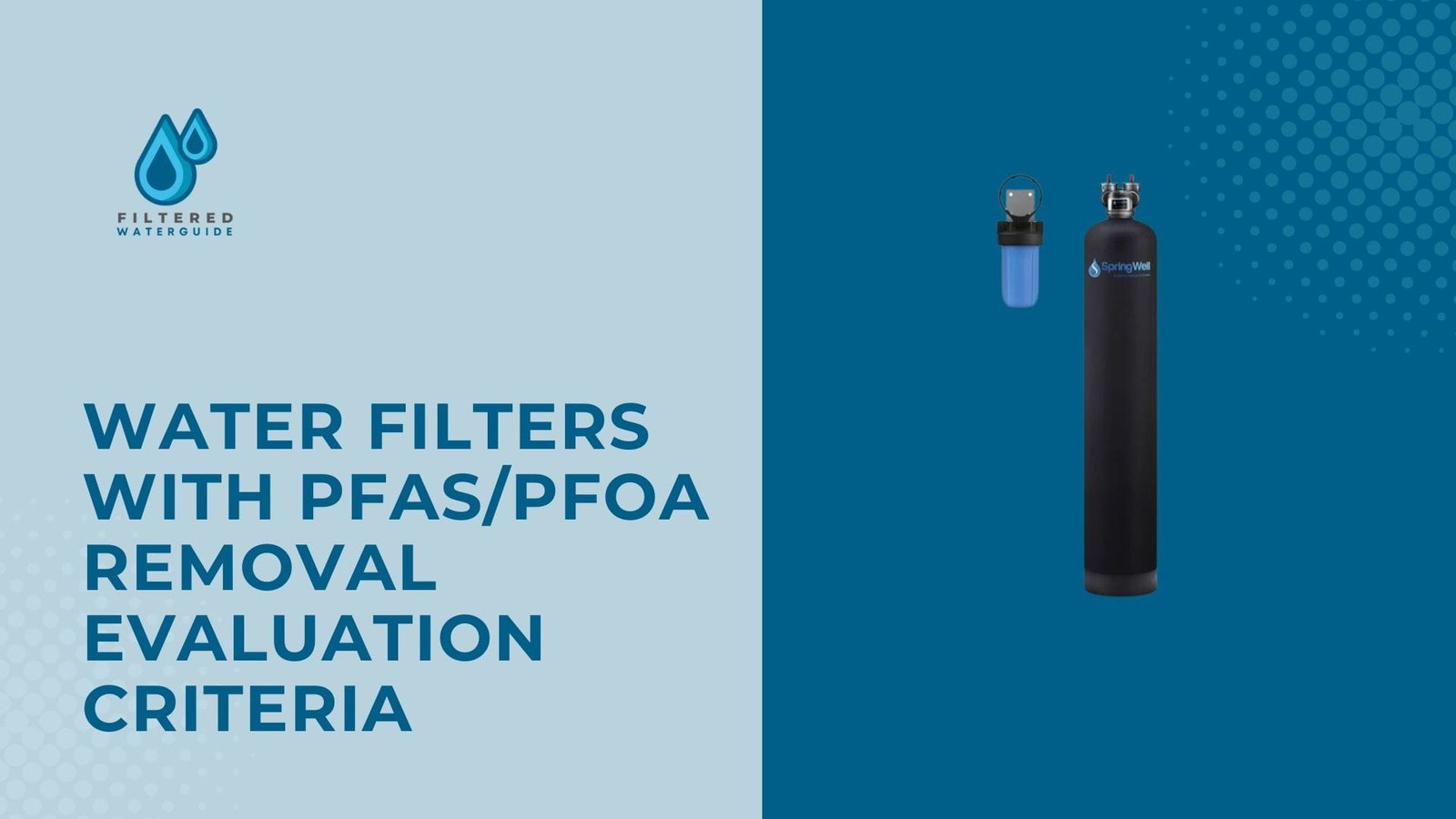
Through our years of testing water filtration systems, we’ve learned that selecting the right filter for PFAS and PFOA removal requires careful consideration of multiple factors. As a team of water quality experts, we’ve developed a comprehensive evaluation framework based on real-world testing and analysis.
We’ve created this detailed assessment guide to share our testing methodology and help you make an informed decision. Our criteria reflect both technical performance and practical considerations, ensuring you select a system that delivers clean water while providing reliable long-term value.
Through our extensive laboratory testing, we’ve found that understanding filtration technology is critical for effective PFAS and PFOA removal. Our research has evaluated various filtration methods, and we’ve documented how each one tackles these persistent chemicals in different ways.
In our testing facility, we’ve consistently observed that reverse osmosis (RO) systems demonstrate exceptional PFAS and PFOA removal capabilities, typically achieving up to 90% reduction rates. Our analysis shows that these systems work by creating pressure that forces water through specialized semi-permeable membranes, effectively blocking contaminants.
We’ve evaluated numerous RO systems and found the most effective ones incorporate multiple filtration stages. Through our testing, we’ve confirmed that this multi-stage approach provides more comprehensive water purification than single-stage systems.
While testing activated carbon filters, we’ve observed that they offer a different approach to contamination removal. Though our data shows they’re generally less effective than RO systems for PFAS and PFOA specifically, they still play a valuable role in water purification.
Our laboratory analysis has revealed how water flowing through granular activated carbon creates multiple opportunities for PFAS and PFOA capture. We’ve found that many high-performing systems combine activated carbon with other filtration methods to maximize effectiveness.
Through our research, we’ve identified ion exchange as another reliable method for PFAS and PFOA removal. Our testing demonstrates how these systems effectively swap harmful contaminant ions with benign sodium ions. The process occurs when water contacts specialized ion exchange resins, neutralizing and removing harmful substances.
Based on our field experience, we’ve noted that many homeowners are already familiar with this technology through water softeners, making it an accessible option for PFAS and PFOA removal.
Through our years of product testing and evaluation, we’ve identified several key factors that indicate a filter’s reliability and performance potential.
Our research consistently shows that certification from organizations like the National Sanitation Foundation (NSF) provides reliable validation of a filter’s capabilities.
In our professional experience, NSF-certified filters have demonstrated consistent performance in independent laboratory testing. We’ve found this third-party verification particularly valuable when evaluating manufacturers’ performance claims.
During our product assessments, we’ve learned that warranty coverage often reflects a manufacturer’s confidence in their system. We’ve observed that companies offering longer warranty periods typically produce more reliable products.
While our testing shows that shorter warranty periods don’t always indicate inferior quality, we’ve found that comprehensive warranty coverage provides valuable long-term protection for your investment.
Based on our extensive field testing, we consider flow rate a crucial performance indicator. Our research shows that insufficient flow rates can significantly impact a system’s practical usefulness.
We’ve found through our household studies that matching your water usage patterns with appropriate flow capacity is essential. Our testing has repeatedly shown that even the most effective filter becomes impractical if it can’t meet your daily water demands.
Through our market analysis and performance testing, we’ve discovered that price doesn’t always correlate directly with effectiveness. When comparing similarly specified systems, we often find that mid-range options can provide excellent PFAS and PFOA removal capabilities.
Our experience has taught us that the most expensive system isn’t always the best choice. We believe in finding the sweet spot between performance and affordability. Through our testing, we’ve identified systems at various price points that effectively remove these contaminants while providing good value.
In evaluating hundreds of filtration systems, we’ve concluded that the ideal choice balances these key factors:
Our research shows that understanding these criteria helps ensure you select a system that not only removes harmful contaminants effectively but also provides lasting value for your investment.
After extensively testing numerous filtration systems for PFAS and PFOA removal, our team remains confident in recommending any of the systems we’ve reviewed above. Through our comprehensive evaluation process, we identified the SpringWell system as our top recommendation based on its exceptional performance across our testing criteria.
Our hands-on experience with each system has revealed their unique strengths, which we’ve detailed throughout this guide. Whether you’re looking for whole-house protection or point-of-use filtration, we’ve found these systems consistently deliver reliable contamination removal.
Based on our testing results, we can confidently say that selecting any of these filtered water solutions will effectively reduce PFAS and PFOA in your water supply. We recommend comparing their specific features against your household needs and priorities. Through proper system selection and maintenance, you’ll ensure safer, cleaner water for your family’s long-term health and well-being.